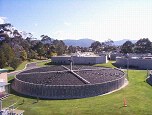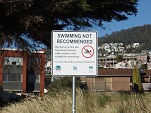Excerpts from Moss et al. (2006) [1]
 Stressors were defined in [2] as follows: Physical, chemical and biological stressors are major components of the environment that, when changed by human or other activities, can result in degradation to natural resources. Stressors can be:
Stressors were defined in [2] as follows: Physical, chemical and biological stressors are major components of the environment that, when changed by human or other activities, can result in degradation to natural resources. Stressors can be:
- a component of the environment that transfers the impact of a pressure (e.g. human activity) to other parts of the environment by being changed from its natural state (e.g. nutrient concentrations changed from natural, habitat coverage less than natural or excess salt). These components of the environment are usually present in natural (healthy) ecosystems and are only considered stressors when they are different from natural;
- a component of the environment that, when present, causes stress on the ecosystems (e.g. litter or pest species). These components of the environment are not usually present in natural (healthy) ecosystems and are considered potential stressors when they are present in any amount [2].
The definition of stressors is somewhat broad, and identification of stressors within the limits of this definition is still largely based on expert opinion [1].
Why use the “stressor” terminology?
Based on excerpts from Scheltinga et al. 2004 [2]:
 The stressor terminology was designed to provide a common starting point for the process of selecting indicators based upon regional situations. Key environmental stressors are used in the framework rather than specific natural resource management (NRM) issues because stakeholders do not all use the same language when describing these issues. NRM issues can be defined as causes or symptoms of natural resource problems (Figure 1), and the terms “pressures”, “issues” “problems” or even “indicators” are often used interchangeably. Therefore, it is not possible to compile a comprehensive list of NRM issues with specific indicators for each.
The stressor terminology was designed to provide a common starting point for the process of selecting indicators based upon regional situations. Key environmental stressors are used in the framework rather than specific natural resource management (NRM) issues because stakeholders do not all use the same language when describing these issues. NRM issues can be defined as causes or symptoms of natural resource problems (Figure 1), and the terms “pressures”, “issues” “problems” or even “indicators” are often used interchangeably. Therefore, it is not possible to compile a comprehensive list of NRM issues with specific indicators for each.

Figure 1. This diagram shows that causes or symptoms of natural resource problems and stressors are all commonly used to describe NRM ‘issues’. Note also that community-held values influence the choice of indicators through the causes (management actions) and stressors to be addressed by management actions [from 2].
Some estuarine coastal and marine stressors
 A set of 16 defined stressors were identified in a former Coastal CRC project [2] and these were subject to expert review at two national workshops, held under the auspices of NHT and NAP. These stressors are listed below. You can follow the hyperlinks to obtain lists of the causes of change to stressors, some of the symptoms (i.e. impacts on the system) that might result from them, some potential indicators to monitor the stressors and links to external information sources.
A set of 16 defined stressors were identified in a former Coastal CRC project [2] and these were subject to expert review at two national workshops, held under the auspices of NHT and NAP. These stressors are listed below. You can follow the hyperlinks to obtain lists of the causes of change to stressors, some of the symptoms (i.e. impacts on the system) that might result from them, some potential indicators to monitor the stressors and links to external information sources.
- Altered pH |
- Aquatic sediments |
- Connectivity |
- Disturbance to Biota |
- Excess freshwater |
- Excess nutrients |
- Excess salt |
- Freshwater flow regime |
- Habitat removal/disturbance |
- Hydrodynamic |
- Litter |
- Organic matter |
- Pathogens |
- Pest species |
- Toxicants |
- Water temperature |
Stressor Models
 View new conceptual models illustrating 12 important stressors affecting your waterways: Stressor models are used to show how human activities (i.e. threat models) interact with the natural processes occurring in an estuary (i.e. process models) and impact the ecosystem. This allows pressure and condition indicators to be determined that are specific to a particular stressor and estuary type.
View new conceptual models illustrating 12 important stressors affecting your waterways: Stressor models are used to show how human activities (i.e. threat models) interact with the natural processes occurring in an estuary (i.e. process models) and impact the ecosystem. This allows pressure and condition indicators to be determined that are specific to a particular stressor and estuary type.
A set of 13 defined stressor models were identified by
- Altered pH|
- Aquatic sediments |
- Connectivity |
- Disturbance to biota |
- Excess nutrients |
- Freshwater flow regime|
- Habitat removal/disturbance |
- Hydrodynamics|
- Litter|
- Organic matter |
- Pathogens|
- Pest species |
- Toxicants
References
- Andrew Moss, Melanie Cox, David Scheltinga, David Rissik. 2006, Integrated estuary assessment framework, Cooperative Research Centre for Coastal Zone Estuary and Waterway Management Technical Report 69.
- Scheltinga, D., Counihan, R., Moss, A., Cox, M., Bennett, J. 2004, Users’ Guide to Estuarine, Coastal and Marine Indicators for Regional NRM Monitoring, Report to DEH, MEW, ICAG, Coastal Zone CRC.


